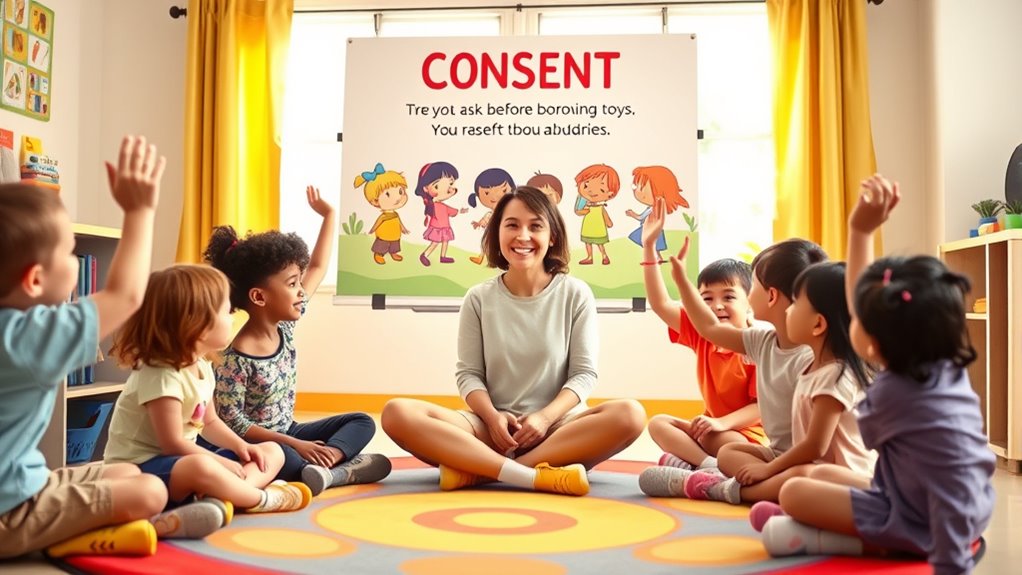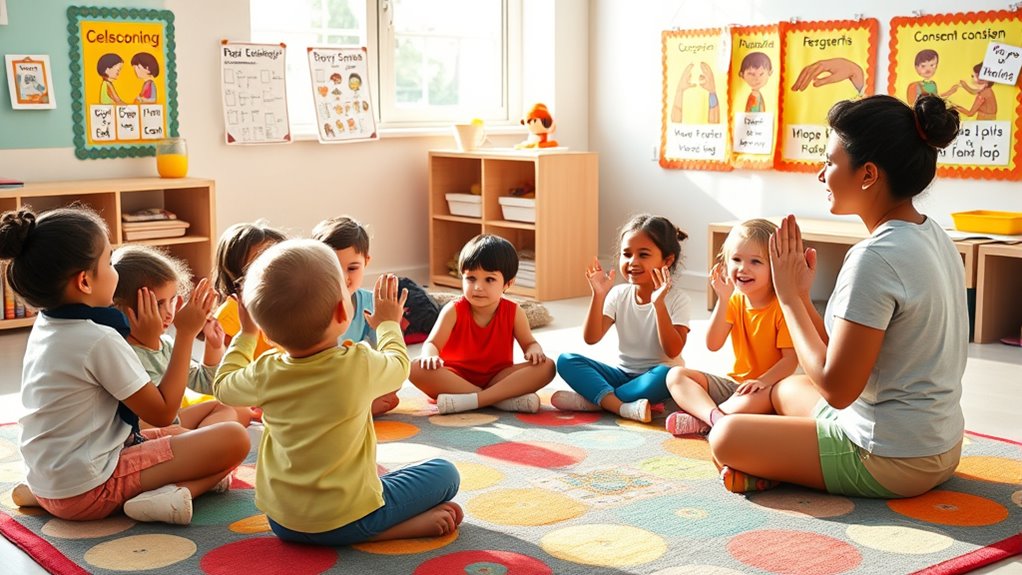To teach kids about consent effectively, use age-appropriate examples that match their development level. For young children, say things like “It’s okay to say no to hugs or kisses,” while for older kids, encourage polite ways to decline sharing toys or activities. Model respectful interactions and ask permission before touching or taking things. Making consent part of everyday conversations helps children understand boundaries naturally. Keep exploring these practical tips to build respectful, safe relationships now and in the future.
Key Takeaways
- Use simple, relatable scenarios like asking before hugging or sharing toys to demonstrate consent at different ages.
- Model respectful communication by explaining boundaries clearly and encouraging children to express themselves honestly.
- Reinforce that children can say no without guilt, affirming their body autonomy and comfort levels.
- Teach the importance of asking permission before touching others or taking their belongings.
- Praise and correct daily interactions to embed consent as a natural, ongoing practice.

Teaching consent to children is essential for helping them understand boundaries and develop healthy relationships. When you introduce the concept early, you’re empowering them to recognize their own body autonomy and respect others’ personal space. One effective way to do this is through respectful communication, which involves modeling and encouraging honest, kind, and clear interactions. Start by explaining that everyone’s body belongs to them, and they have the right to say no to anything they’re uncomfortable with. Reinforce that their feelings matter, and they should trust their instincts. When children see you practicing respectful communication, they learn to express themselves and listen to others in a positive way.
Teaching children about consent fosters respect, boundaries, and healthy communication from an early age.
Using age-appropriate examples makes these lessons more relatable. For very young children, you might say, “If you don’t want a hug or a kiss, it’s okay to say no. I’ll listen and respect your choice.” This teaches them that their feelings are valid and that they have control over their body. For slightly older children, you can introduce scenarios like sharing toys or choosing whether to participate in activities, emphasizing that they can say yes or no without feeling guilty. For example, “If your friend wants to play a game but you don’t feel like it, you can politely say, ‘No, thank you,’ and they should respect that.” These examples help them understand body autonomy in everyday situations, reinforcing that they’re the best judge of their own comfort.
It’s also important to teach children to recognize and respect the boundaries of others. Encourage them to ask permission before touching someone or taking something, and to wait for a clear “yes” before proceeding. This instills respect for body autonomy not just in themselves but also in their interactions with others. When they see you modeling this behavior—asking before hugging a friend or explaining their own boundaries—they learn that respectful communication is a cornerstone of healthy relationships. Additionally, discussing appropriate touch and personal boundaries helps children internalize these concepts more deeply.
Reinforcing these lessons consistently helps children internalize the importance of consent from a young age. Praise them when they practice respectful communication, and gently correct any instances where they might overlook someone’s body autonomy. By doing so, you create an environment where consent isn’t just a concept but a natural part of their daily interactions. Teaching children about consent now sets the foundation for respectful, safe, and trusting relationships in the future, helping them navigate their social world with confidence and empathy.
Frequently Asked Questions
How Can I Teach Consent to Very Young Children?
To teach very young children about consent, start with respectful communication and personal boundaries. Use simple language to explain that they can say no if they’re uncomfortable, and encourage them to listen when others do the same. Role-play scenarios, like asking before hugging, help them understand boundaries. Reinforce these lessons with gentle reminders, fostering a safe environment where they learn that their feelings and choices matter.
What Are Some Common Mistakes to Avoid?
You might believe that teaching consent is straightforward, but avoid common mistakes like neglecting boundary setting or ineffective communication. Always clarify boundaries clearly and respect children’s responses. Don’t dismiss their feelings or pressure them into decisions. Instead, model respectful interactions and encourage open dialogue. By focusing on boundary setting and practicing effective communication, you help children learn consent authentically and build trust, reducing misunderstandings or confusion as they grow.
How Do I Handle Resistance From Children?
When children resist, you should respect their feelings and give them space to express themselves. Focus on setting clear parental boundaries that promote safety and trust. Recognize their emotional readiness, and don’t force answers or actions they’re uncomfortable with. Instead, encourage open communication, listen actively, and reassure them. Over time, this approach helps children understand consent while feeling secure and respected in their boundaries.
When Is the Right Age to Introduce Consent Concepts?
They say “it’s never too early,” and that’s true when it comes to teaching kids about consent. You can start with age-appropriate explanations as early as age three, introducing simple consent boundaries like asking before touching or sharing. As children grow, you can build on these concepts, ensuring they understand boundaries and respect others’ feelings. Early lessons lay the foundation for healthy, respectful relationships throughout their lives.
How Can I Model Good Consent Behavior Myself?
You can model good consent behavior by consistently demonstrating respect and setting clear boundaries. Always ask permission before touching others or their belongings, and respect their responses. Show children how to communicate openly and listen actively. By respecting their boundaries and practicing consent yourself, you teach them essential lessons about respecting others, building trust, and understanding personal limits. Your actions serve as a powerful example they’ll carry into their own interactions.
Conclusion
As you teach children about consent, remember that even small moments can shape their understanding. It’s funny how, just when you think a lesson might not stick, they surprise you with their respect and boundaries. By consistently using age-appropriate examples, you help them develop confidence and empathy. Ultimately, your efforts plant seeds that grow into lifelong habits of respecting others’ feelings—proof that even the tiniest lessons can lead to meaningful change.








